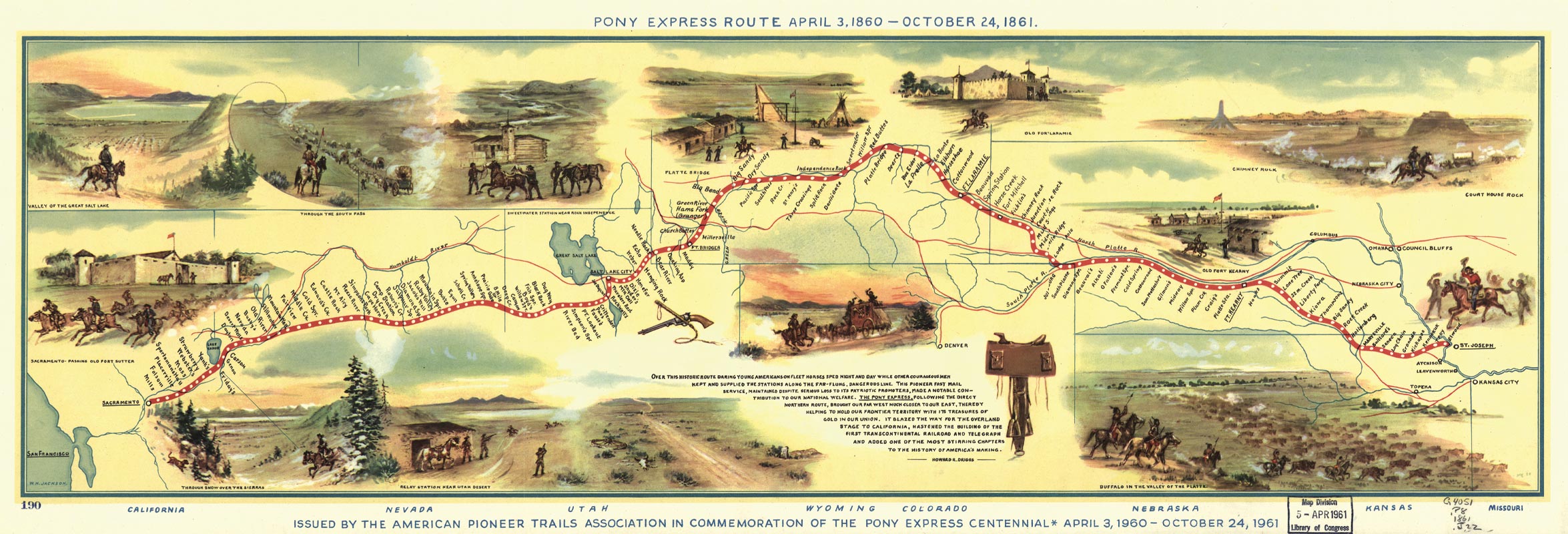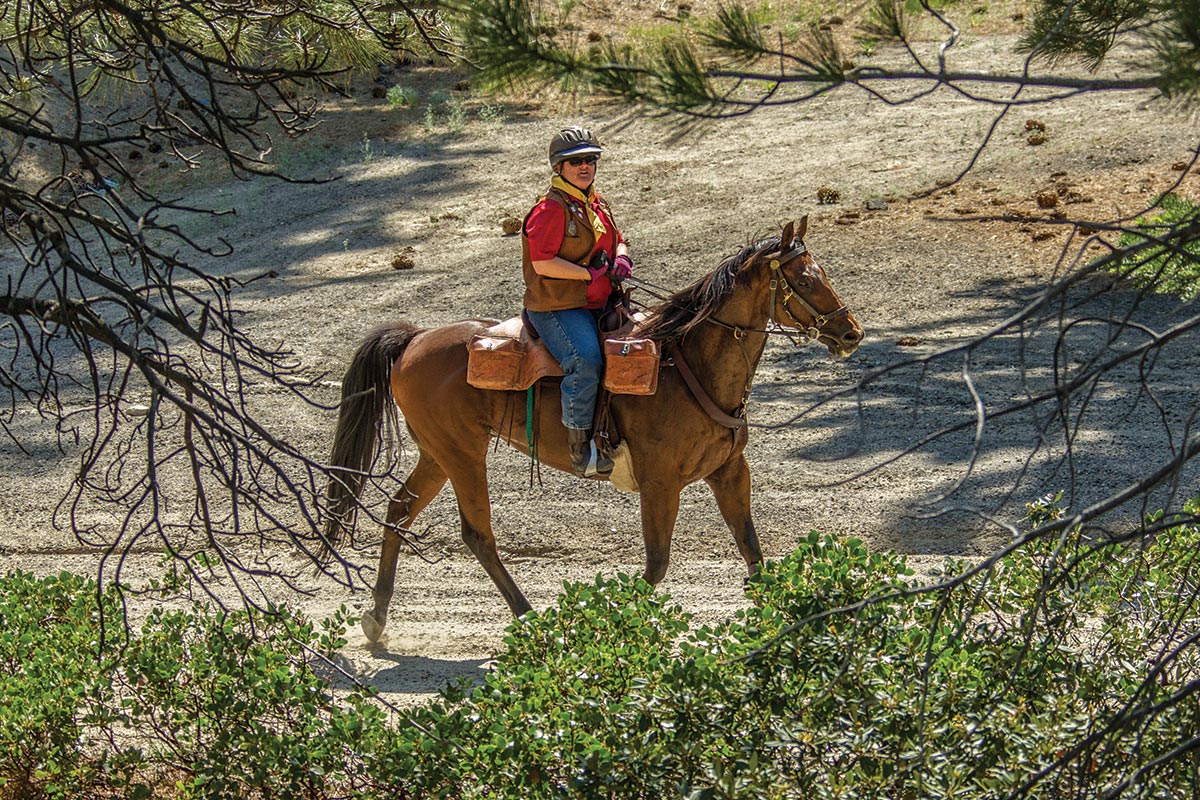From April 1860 to October 1861, hundreds of young men rode relays between Sacramento, Calif., and St. Joseph, Mo., delivering letters for along the Pony Express Trail. Though short-lived, the system was the first truly rapid mail service to cross the Rocky Mountains and connect communities out west with those east of the Missouri River.

Today, tourists can cycle, hike, drive, and ride parts of the more than 1,800-mile route, and intrepid equestrians can replay the adventure on their own mounts by joining the National Pony Express Association’s annual Re-Ride.
The Pony Express Trail
In 1775, just one year before declaring independence from Great Britain, the Second Continental Congress established the Postal Service. Benjamin Franklin took the helm, serving as the first Postmaster General, and established an impressive mail system that ran from Florida to Maine and connected the colonies to Britain.
Franklin left the job in 1776, but by then other leaders of the time, such as James Madison, had also begun to embrace the role of the post in bolstering a nascent democracy.
For the next 80 years, mail delivery continued to expand along the eastern seaboard and west to the Missouri River, evolving from a system dependent on stagecoaches to one that made use of railroads.

By the mid-1800s, settlers were heading west as part of the Gold Rush, the Mormon exodus to Utah, and a misguided sense of Manifest Destiny, putting down roots in lands still inhabited by hundreds of thousands of Native Americans.
For the first half of the 19th century, the town of St. Joseph, Mo., was the westernmost point reached by railroad or telegraph. Consequently, while communication sped along in the East, it limped between the smattering of outposts and towns across the Great Plains, Rocky Mountains, and beyond. What’s more, with the still-young nation on the brink of civil war and California pondering secession, connection became a political imperative.
At that time, one needed patience to send mail to or from California. By stagecoach, the trip averaged 25 days; by sea, it took months. But a trio of transportation pioneers—William H. Russell, Alexander Majors, and William B. Waddell—had a solution. Horse-rider teams, they said, could cover the rugged landscapes much more quickly.

From January to March of 1860, the team, operating as the Central Overland Trail and Pikes Peak Express Company, set up relief stations along the route, purchased more than 400 horses, and began advertising for riders. According to the book Orphans Preferred: The Twisted Truth and lasting Legend of the Pony Express, one ad from a California newspaper at the time read as follows:
Wanted. Young, skinny, wiry fellows. Not over 18. Must be expert riders. Willing to risk life daily. Orphans preferred.
The work, clearly, would be risky. The Pony Express route stretched 1,966 miles from California to Missouri, crossing through what is now Colorado, Kansas, Nebraska, Nevada, Utah, and Wyoming, which were territories at the time. Weather was extreme, terrain was rough, and threat of attack almost imminent.
But it worked. Instead of taking almost a month, letters, newspapers, and more could now reach California in as little as 10 days, and only one bag of mail was reported lost during the service’s 18 months in operation.
Dollars and CentsThe initial cost of a half-ounce letter sent via Pony Express was $5, about $150 in today’s dollars. Though the mochila could carry 20 pounds of mail, they usually only held a few dozen letters. The mail rate was later dropped to $1, but due to a war hiatus and failure to land a government contract, the Pony Express was a colossal money-loser, winding up around $200,000 in the red. Riders were paid $100-$150 per month, around $3,000-$4,700 today—not a bad payday for a teenager. |
That degree of efficiency is somewhat amazing considering that the Pony Express functioned as a relay. To live up to the “express” nature of the system, riders averaged 10 miles per hour—which equates to a fast, extended trot or a leisurely lope—and rode day and night. Between 165 and 190 relief stations were scattered along the route.
Most riders covered 75 to 100 miles on a given leg, while horses only went 10 to 15 miles. When he arrived at a station, a rider simply moved his mochila—a leather skirted saddle cover with pockets—to his fresh (already tacked) mount, hopped aboard, and got back on the road.
Riding the Pony Express Trail
The last Pony Express rider finished his run on November 20 of 1861, less than a month after the completion of the transcontinental telegraph that rendered the service obsolete. In the years that followed, much of the original trail was swallowed by land development, but in 1992, Congress added the Pony Express National Historic Trail to the National Trails System.
Today, almost the entire route can be followed by horse, foot, or auto, and it still cuts through some of the U.S.’s most remote and dramatic landscapes. An interactive map highlights sites along the route, such as Oregon Trail ruts, a stagecoach ambush site, and ruins of an old Pony Express relief station. Because there is not a continuous route, riders should research equestrian-friendly trails along the route within the state where they want to ride.

For those who want a sense of what it was like to carry mail on horseback in the 1800s, consider participating in a re-ride. These events have been happening sporadically since the early 20th century, as history buffs and horse enthusiasts commemorated the legendary trail on horseback.
In 1935, a group of 300 Boy Scouts carried letters from governors and other officials to then-President Franklin D. Roosevelt. In 1960, the National Pony Express Centennial Association organized a re-ride to celebrate the 100-year anniversary of the service.
In the mid-1960s, an avid group of trail riders began riding and re-enacting parts of the route. In 1977, they formed the National Pony Express Association (NPEA), an organization dedicated to preserving the trail, its sites, and its history. By 1980, they had extended their re-ride to incorporate the entire distance, from Sacramento to St. Joseph.
Now, the NPEA organizes a 10-day annual event in which more than 700 horse-and-rider teams can don costumes—red western shirts, blue jeans, a yellow scarf, and cowboy boots—and deliver actual mail, riding east-to-west and west-to-east on alternate years.

“Riders ride legs from 2 to 5 miles or so, depending on the terrain,” explains NPEA Stablemaster and media spokesperson Mary Cone. “They may ride more than one leg, leap-frogging ahead as needed.”
While the legs are shorter than they were back in the day, and modern equestrians must provide their own mounts, the experience will be reminiscent of the original in a few key ways: riders are expected to average 10 mph; letters are carried by mochila; and they carry the mail 24/7.
“Just like the old days,” Cone says.
How to Join the Pony Express
In order to participate, riders must be at least 14 (with parental consent for those under 18) and signed up for the state division where they hope to ride. Visit NPEA’s website for more details.
All horses should be properly conditioned and equipped for the pace of the event, and NPEA recommends riding your segment ahead of time. For example, a horse may need to cross concrete, cope with people cheering, face extreme wilderness, or wade rivers. Some states are more commonly in need of riders.
Although the COVID-19 pandemic interfered with the 2020 event, the 2021 event is slated for June 16-26. If you want to participate but aren’t sure about saddling up yourself, send a letter or follow the progress of the mail via an interactive map.
This article about the pony express appeared in the May 2021 issue of Horse Illustrated magazine. Click here to subscribe!





